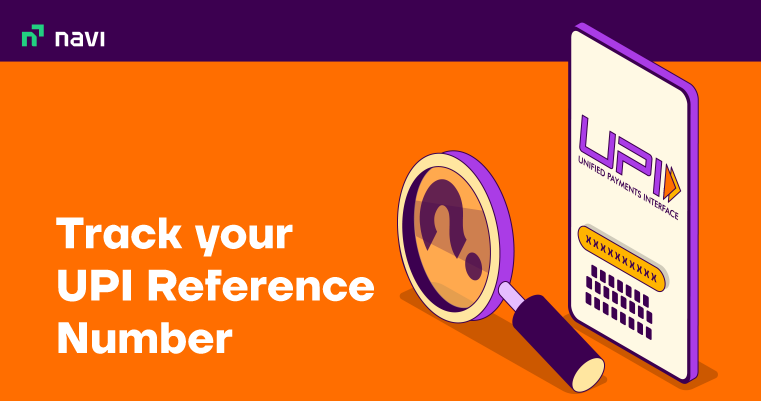How to Find and Track UPI Reference Number?

Unified Payments Interface (UPI), a payment system developed by the National Payments Corporation of India allows digital transfer of money quickly and seamlessly at no additional cost. Each digital transaction has a UPI Reference Number which is a unique 12-digit reference number associated with each transaction. It is generated for every transaction and allows users to track their transactions. If users have any queries about a transaction, they can check the UPI Reference Number tracking associated with the payment and use it to fetch all the details.
Read on to know how to find UPI reference number, how to track it and other details.
How to Find UPI Reference Number?
It is critical to keep an eye on the UPI reference number, especially when dealing with large sums of money. Users can find the UPI reference number on the app’s interface depending on the payment aggregator.
Google Pay UPI Reference Number
- Step 1: Open the Google Pay App and navigate to show “Transaction History”
- Step 2: To verify the reference number click on any transaction.
- Step 3: You will find the UPI transaction ID which is a 9 digit number
Paytm UPI Reference Number
- Step 1: Open Paytm and select the “Passbook” option
- Step 2: Select the list of transactions and choose the specific transaction you need. With the required UPI reference number in hand, you can track the concerned transaction.
PhonePe UPI Reference Number
- Step 1: Visit the PhonePe App and navigate to the “History” section
- Step 2: Click on any transaction and check the transfer details
- Step 3: You will find the UTR number which is a 12 digit unique number
How to Track UPI Reference Number?
For UPI transaction reference number tracking, users can get details by selecting the required payment from the list of transactions. Upon choosing the transaction, the user can find the reference number. If there is an ambiguity regarding the payment, one can contact the bank or the merchant regarding the status. Here are steps for UPI reference number tracking.
- Step 1: Open any App of your choice such as Paytm, Google Pay, PhonePe, etc.
- Step 2: Select the ‘Passbook’ section if you are using Paytm and ‘History’ section if you’re using Phonpe or Google Pay.
- Step 3: Select the bank account you use for UPI payments, click on the transaction you require the UPI reference number.
- Step 4: Note the 12-digit UPI reference number.
- Step 5: Using the above steps, you can easily track UPI reference numbers whenever you need them.
What is UPI Reference ID?
A UPI reference ID is a unique identifier assigned to each bank account that allows for the uninterrupted transfer of funds from one account to another. It is a unique address assigned to each user, also known as the virtual payment address (VPA). UPI reference number is essentially a 12-digit reference number that you can use to track your transactions and contact customer service if you have any questions about your UPI transaction.
How to Find UPI Reference ID?
Users must create a UPI reference ID if they want to make transactions on the payment system. Depending on the type of payment aggregator, UPI IDs may look different. A UPI ID is made of two parts separated by “@”. For example, some apps may use the format: phonenumber@nameofapp or username@nameofbank.
- Step 1: The first part consists of details about the user, such as the name or phone number.
- Step 2: The second part contains details of the bank providing services to the UPI app. This portion of the ID includes the full name or just the abbreviation of the bank’s name, along with a prefix or suffix where required.
- Step 3: Users can find the UPI ID using a few simple steps –For apps such as GooglePay, Phone Pe and BHIM, you can find your UPI reference IP by clicking the “Profile” option. Here you will find the bank account and its associated UPI ID. On Paytm, you can select the BHIM UPI option on the landing page to view your ID, while on Mobikwik, it is available on the home page.
What is a Reference ID in a Bank?
A reference ID in a bank is the unique ID associated with all online and offline transactions. These reference IDs enable customers and banks to monitor financial transactions. While tracking transactions, simply producing this ID can fetch all the transaction details, making the tracking process simpler.
In the context of UPI, too, two types of references are involved. One is the UPI reference ID, which is an identifier of your bank account. The second is the UPI reference number which tracks the transaction between the two bank accounts.
Also Read
Why is Everyone Using UPI Reference ID?
UPI provides ease of transactions and accessibility. Importantly, the payment system allows secure transfer of funds. Moreover, UPI transactions are free of cost, encouraging more users to take the cashless route. Users only need a bank account linked to UPI and a unique UPI ID.
UPI transactions can be completed within seconds using a mobile phone and your reference ID. With all the transaction data, including the UPI reference number, available on the payment aggregator app, users need not depend on banks to retrieve the transaction history on their behalf. In the event of any ambiguity in the transaction, users can raise a complaint on the payment aggregator app or site.
UPI payments are not bound by the structural limitations of a bank or other financial institutions. Office timings and bank holidays do not apply to UPI transactions. Users can make payments from the comfort of their homes at any time of the day as long as they have enough funds in the linked bank account and the UPI ID.
How to Get Started With Using UPI?
If you are a new user, you must create a UPI ID to initiate and receive payments digitally.
- Step 1: Download the required application, your mobile number. This number should also be linked to the bank account(s) that you intend to use.
- Step 2: Verify your phone number with the OTP sent via a text message.
- Step 3: Choose your bank name from the list, set up a UPI PIN if you are linking your bank for the first time. The setup will require your debit card details.
- Step 4: Your bank account is now linked via UPI.
How to Send Money Through UPI?
UPI is extremely popular among users because it is easy to use. Once you have linked your bank account and created a UPI ID, you can send and receive funds on the payment aggregation platform of your choice.
There are several ways in which you can send or receive money.
1. Receiver’s Mobile Number
One of the most popular ways to send money is by entering the merchant’s or receiver’s mobile number on the app. You can either enter the number manually or select the contact from your phonebook. Once this number is selected, you can enter the amount, followed by the UPI PIN created while setting up the account.
2. UPI QR Code
You can also transfer funds by scanning a UPI QR code. This preferred payment mode for merchants involves customers scanning the QR code on the payment app. Then the amount to be paid is entered, followed by the UPI pin.
3. UPI ID
You can also send money by entering the UPI ID of the receiver in the payment app of your choice. Enter the unique UPI ID of the merchant/receiver followed by the amount to be sent. Follow this up with your UPI pin and the transaction is initiated.
4. Bank Details
UPI payments also allow users to transfer funds with bank details. This entails providing the recipient’s account number and IFSC code to initiate the payment.
Final Word
UPI is one of India’s most popular digital payment systems. The payment system records hundreds of crores of transactions every month. To make the payment system easy to use and secure, UPI involves certain specifications such as to check UPI reference IDs and record UPI reference numbers. UPI IDs refer to the unique identifier assigned to each user and are a prerequisite to sending and receiving payments on UPI. UPI reference number tracking can be done with a 12-digit ID assigned to each UPI transaction.
FAQs
Currently, there are no transaction charges for UPI payments. The Ministry of Finance, in August 2022, stated that there was “no consideration” regarding levying transaction fees for UPI.
If you enter non-existent receiver details, such as the UPI ID or contact number, the transaction will fail. It may also occur that the incorrect details belong to another third-party recipient. So, always confirm the name of the recipient.
You can make payments throughout the year at any time. UPI payments do not depend on bank timings on holidays.
UPI offers real-time refunds for declined transactions. However, if you do not receive the money back within an hour or so, contact the bank, and they will inform you when the money will be reverted.
Pending UPI transactions are usually deposited in the receiver’s bank account within 48 hours. The delay could be due to technical issues. If the delay extends beyond 48 hours, you can contact the bank.
No, its safe not to share your UPI reference number.

Customer’s Feedback
No comments found.10 Best Bank for Savings Account in India [Highest Interest Rate 2023]
Savings account is a type of financial instrument offered by several banks. It lets you safely depo... Read More »What is Issuer Identification Number (IIN)- Working and Importance
What is an Issuer Identification Number (IIN)? Banks and financial institutions assign a distinc... Read More »What is a Vostro Account – Meaning, Working and Difference
What is a Vostro Account? A Vostro account is a bank account held by a domestic bank on behalf o... Read More »What is a Solvency Certificate? – Format, Documents Required & How to Apply Online?
What is a Solvency Certificate? A solvency certificate is a legal document furnishing the detail... Read More »What is Merchant Banking – Services, Features, Functions and Example
What is Merchant Banking? Merchant banking is a set of select banking and financial services off... Read More »Automated Clearing House: Objectives, Types and Process
Automated Clearing House is an electronic fund transfer network that manages automatic and direct... Read More »How to Redeem Credit Card Reward Points ?
Credit Card Reward points are types of incentives that customers receive when they use a credit car... Read More »What is Electronic Clearing Service (ECS) in Banking and How does it Work?
What is Electronic Clearing Service (ECS)? Electronic Clearing Service (ECS) is a method of elec... Read More »What are Credit Card Validators and How to Use them?
What is a Credit Card Validator? A credit card validator is a tool that checks the validity of a... Read More »What is Cash Management and How Does it Work?
Managing available capital can make sure that a small business stays afloat. Cash management is an ... Read More »What are Prepaid Expenses? – Definition, Examples, and Journal Entry
Prepaid expenses represent payments made in advance for products or services expected to be incurre... Read More »Increase Credit Card Limit – Important Tips and How to Do It?
The credit card limit is the maximum amount of money you can spend using your credit card. Your cre... Read More »Top 10 Chit Fund Schemes in India in 2023
Chit funds are one of the most popular return-generating saving schemes in India. It is a financial... Read More »10 Best Gold ETFs in India to Invest in April 2023
Gold ETFs or Gold Exchange Traded Funds are passively managed funds that track the price of physica... Read More »10 Best Demat Accounts in India for Beginners in 2023
Creation of Demat accounts revolutionised the way trades were conducted at the stock exchanges. It... Read More »20 Best Index Funds to Invest in India in April 2023
What is an Index Fund? An index fund is a type of mutual fund or exchange-traded fund (ETF) that... Read More »Best Arbitrage Mutual Funds to Invest in India in April 2023
Arbitrage funds are hybrid mutual fund schemes that aim to make low-risk profits by buying and sell... Read More »10 Best SIP Plans in India to Invest in April 2023
What is SIP? SIP or Systematic Investment Plan is a method of investing a fixed amount in ... Read More »10 Best Corporate Bond Funds in India to Invest in April 2023
Corporate bond funds are debt funds that invest at least 80% of the investment corpus in companies ... Read More »10 Best Bank for Savings Account in India [Highest Interest Rate 2023]
Savings account is a type of financial instrument offered by several banks. It lets you safely depo... Read More »





















